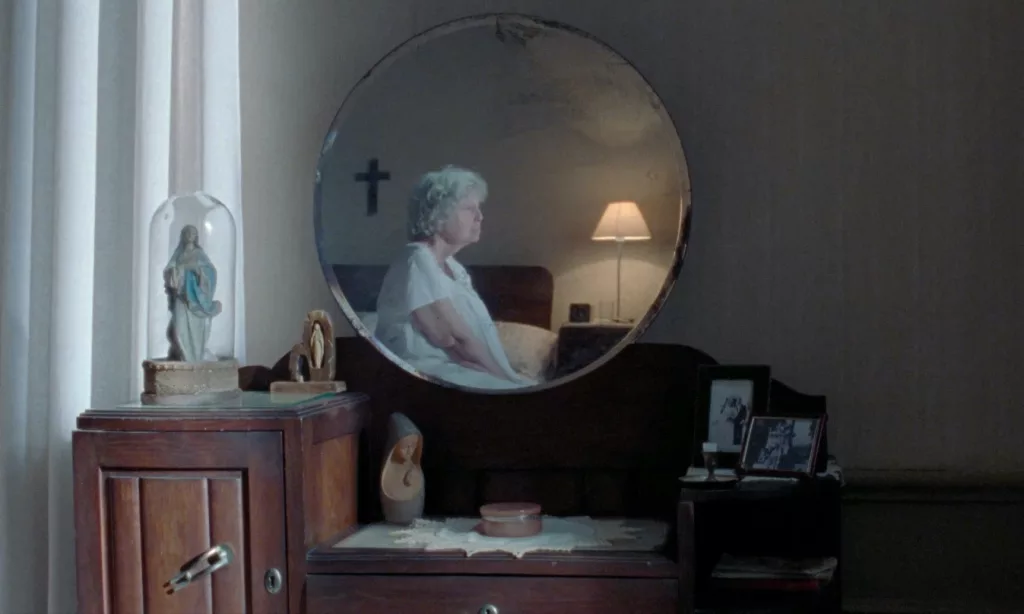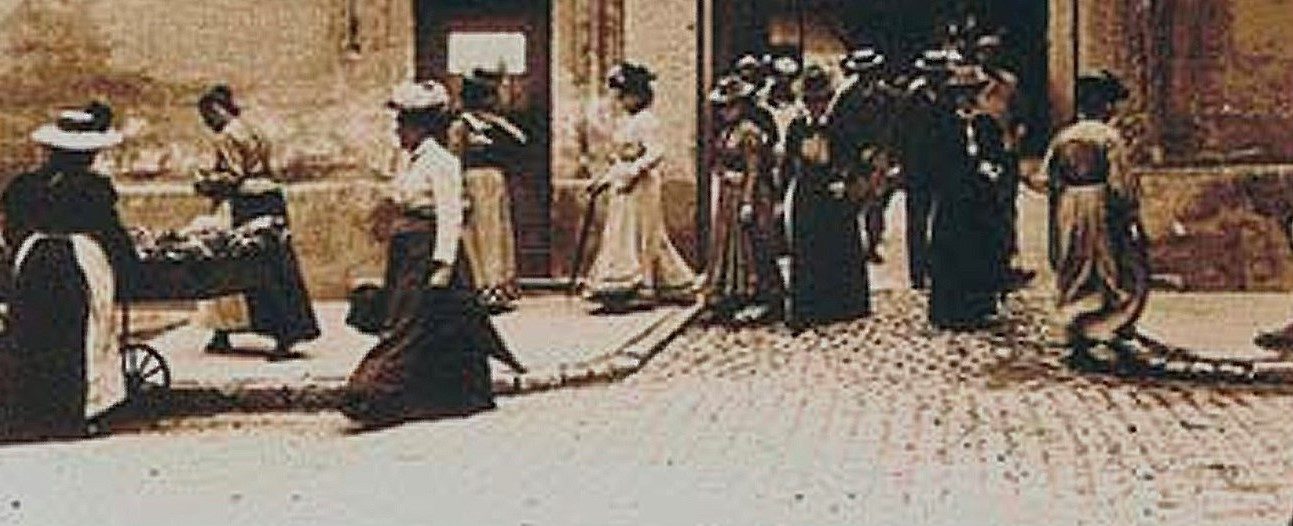Portugal, France, 2024
Directed by André Gil Mata
With Eva Ras (Alzira as an old woman), Gina Macedo (Alzira as a mother), Luísa Guerra (Alzira as a young woman), Márcia Breia (Beatriz), Dinis Gomes (Alzira’s husband)

The camera circles around the table of the dining room as it is laid down by a silent woman for the Sunday lunch, with a man reading his newspaper in an armchair in a corner of the room and a servant standing at a little distance, inside the frame of the door leading the dining room to the kitchen where the meals finish getting cooked and dressed. Put at the level of the table’s surface, the camera circles slowly and endlessly, the back of the old chairs blocking the view and imposing briefly a black screen before the camera can shoot again the ancient, austere, august decoration of the room suiting faultlessly the very old and lavish, typically bourgeois and Portuguese, mansion where the film takes place – there is something mesmerizing to watch fragments of the room and the blackened screen alternate so regularly and so quietly.
So the camera circles and circles, capturing the slow gestures, the splendid cutlery, plates, glasses, clothes, letting the audience feel fully, painfully, the weight of the tradition and the habit, the dullness of doing the same thing and acting for the same ritual. Then the camera keeps circling and circling only to reveal far younger faces, now sitting at the table and praying in an even softer cinematography that what has been exquisitely displayed but with a sharply more colored and cleaner decoration – past has quietly intruded into a present that actually was a not too distant past from the opening scene.
Excruciatingly deliberate and delicate to some, this sequence arguably holds to the others what is the forte, that is the distinct charm, and the purpose, that is the point of a stylistic effort that is not idle, of the film. As two old women, featured as soon as “Sob a chama da candeia” begins, strive to live in this old house, two oldies who barely speak to each other, one already struggling much of the day to stay awake and failing to feel any satisfaction from life, forced to use a cane, while the other is still strong enough to cook and to vacuum, although with a conspicuous displeasure, memories flow back along the corridors and the rooms.
Through regular camera motions that have been crafted as elegant leitmotifs and clever editing suggesting smoothly and subtly echoes between one scene and the next, past segues into the present – or perhaps it is the other way around as the lead character, Alzira, seems to be moving closer to the doors of heaven and thus life can only be wistfully contemplated as it was instead of being lived through for another day. This is as much suggested by the splendid last sequence based on the camera meandering forward through part of Alzira’s house where frozen figures stand before carefully retracing its steps, with any human presence now vanished, finding back the face of the old lady deeply asleep. It happens sometimes that scenes are harder to connect, especially when featuring a restless and nasty child who does not seem to fit in or a bunch of kids whose troubles are not easy to put on any timeline. The point, generations naturally followed each other while Alzira keeps getting old, her health frailer, and her life bleaker.
Shards of the time past end up telling a simple and uninspiring story. A young woman who is skilled enough, though not so much after all, and dedicated enough, and that is for sure, to feel like a real blooming artist, playing Johann Sebastian Bach and painting Rio de Janeiro, accepts to marry a young man mad in love with her. She becomes swiftly the mother of many children and the quiet and quintessential, unassuming and unambitious housewife her very bourgeois and conservative husband and families expect as the nation is frozen by the dictatorship of António de Oliveira Salazar. The children grow up and have other children, the husband gets older and then passes away, the nation is changing, probably, but even as Alzira keeps reading “O Comércio do Porto” or “Jornal de Notícias”, she looks definitely out of reach of any modernity.
The only thing that stirs her deeply, nastily, lurking below her wearied silence, is the growing dislike for her maid and cook, Beatriz, and she manages to get eventually that other surly oldie booted out of the house. As resentment grows and death looms, what transpires through the monotony of days and habits, the old-fashioned and worn-out furniture, baubles, decors, and the wrinkles and stares is the concrete sensation of a life ending its colorless course, a life devoured by chores and habits stifling personalities and snuffing out dreams, a life that was truly and deeply, if not intensely, experienced, but that is going to waste and anyway feels like a burden when embodied by a sour maid.
The film is based on memories director André Gil Mata has of his own grandmother and is clearly inspired by the likes of Chantal Akerman or Manoel de Oliveira. With a soft cinematography avoiding brightness and enhancing a restrained and slightly faded palette of hues fitting the sensation of a fall or of the nice end of a fine day, and in this respect the film’s title sounds like a perfect description before turning out a well kept promise, the film is a deeply intimate portrayal emphasizing dull moments, small gestures, silence, but also letting the occasional, and uncontrollable, emotion reaching the surface of this still life. It leaves many narrative elements unknown when other screenplays would have been more dramatic but that does not diminish the spell it can cast on the mind of the audience, quite the contrary.
This is demonstrated by a scene late in the editing dealing with Alzira’s seminal sorrow of losing her father, who chose when she is still a kid to sail away to try his luck in Brazil, but little more will be told about Alzira’s father, his rationale, the true impact of his departure, how the adventure ended for him; yet the scene possesses a striking emotional power over the audience thanks to the way the camera is set and observe the characters standing at a window and the face of the actor playing the father to this very young Alzira.
The most remarkable achievement is just to fully exploit the ability of the camera, using to great effect a 16mm film, whether it is circling around a table, advancing in a corridor, or swooning from a branch to a kennel only to settle on the old stairway and porch, to show how places and objects can be vessels life and time use to fly away while being witnesses keeping records of that inexorable flight to the haze of the past, loci as well as also memento mori, traps where bodies are doomed to experience the bitterness of life as well as spaces where minds can still have fun, create works, feeling if transiently the power of love.

